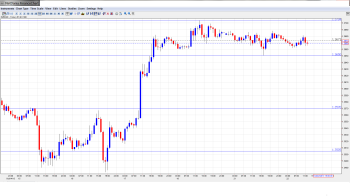EUR/USD is almost unchanged on Tuesday, continuing the lack of movement we saw on Monday. In the European session, the pair is trading in the mid-1.36 range. On Monday, US Existing Home Sales was down, but within expectations. Today’s highlights are Non-Farm Payrolls and the Unemployment Rate, which were not released during the shutdown. There are no Eurozone releases on Tuesday.
Here is a quick update on the technical situation, indicators, and market sentiment that moves euro/dollar.
EUR/USD Technical
- In the Asian session, EUR/USD edged lower, touching a low of 1.3662 and consolidating at 1.3674. The pair is unchanged in the European session.
- Current range: 1.3650 to 1.3710.
Further levels in both directions:
- Below: 1.3650, 1.3570, 1.3500, 1.3460, 1.3415, 1.3325, 1.3240, 1.3175 and 1.3100.
- Above: 1.3710, 1.3800, 1.3870, 1.3940 and 1.4036.
- 1.3650 continues to provide weak support. 1.3570 is next.
- 1.3710 is the next line of resistance. The round number of 1.3800 follows.
EUR/USD Fundamentals
- 12:30 US Non-Farm Employment Change. Exp. 182K.
- 12:30 US Unemployment Rate. Exp. 7.3%.
- 12:30 US Average Hourly Earnings. Exp. 0.2%.
- 13:00 US TIC Long-Term Purchases. Exp. 30.9B.
- 14:00 US Construction Spending. Exp. 0.5%.
- 14:00 US Richmond Manufacturing Index. Exp. 0 points.
- 14:30 US Natural Gas Storage. Exp. 81B.
* All times are GMT.
For more events and lines, see the Euro to dollar forecast.
EUR/USD Sentiment
- Markets Await Non-Farm Payrolls: The recent government shutdown cancelled some US economic releases, notably Non-Farm Payrolls, one of the most important employment releases. The September report was supposed to be released in early October, but has been rescheduled for release later on Tuesday. The NFP release could have a major impact on EUR/USD. Meanwhile, last week’s Unemployment Claims came in at 357 thousand, very close to the estimate of 358 thousand. This figure was an improvement from last week, but still well above previous releases. The shutdown inflated the release, as hundreds of thousands of Federal employees were laid off. This week’s claim is lower, with an estimate of 341 thousand.
- Eurozone inflation remains low: Inflation in the Eurozone continues to be subdued, as underscored by German PPI which posted a modest gain of 0.3%. This was the indicator’s first gain since January. Other inflation indicators have been weak, pointing to sluggish economic activity. The ECB has stated that its inflation target is “close to, but below 2%”, but Eurozone CPI releases continue to fall short of this target and the September release came in at 1.1%. The ECB is reluctant to lower interest rates in order to boost inflation, so it seems low inflation will remain until economic growth picks up.
- Debt ceiling averted, but dollar loses ground: With the US staring at a sovereign default for the first time in its history, the Republicans and Democrats finally reached an agreement last week to reopen the government and raise the debt ceiling. However, the deal provides short-term relief only – the government will be funded until January 15, while the debt limit will be raised until February 7. Both sides have agreed to discuss budget issues and try to reach a long-term agreement before December 13. So we could be right back where we started in just a few months. The Republicans appear to be the big losers in this saga, as they failed to obtain any concessions regarding the Obama health care act and are blamed by most of the public for precipitating an unnecessary political and fiscal crisis. The dollar initially gained ground after the agreement was announced, but was broadly lower as optimism faded. On Friday, EUR/USD touched above the 1.37 line, an eight-month high.
- Fed unlikely to taper QE: The crisis mood in Washington has cleared for now, but the agreement hammered out in Congress provides short-term relief only, as it raises the debt ceiling until early February and funds the government until mid-January. The underlying budgetary issues remain unresolved, and in this tense situation, the Fed is unlikely to push the taper trigger until some time in 2014. Ongoing QE is the main factor weighing on the dollar and we can expect this situation to continue for a while yet.

